Ron Johnston reviews three recent books that, in very different ways, explore the changing nature and politics of the working class in post-industrial societies.
The Working Class Hasn’t Gone Away
The New Politics of Class: The Political Exclusion of the British Working Class. Geoffrey Evans and James Tilley. Oxford University Press. 2017.
The New Minority: White Working Class Politics in an Age of Immigration and Inequality. Justin Gest. Oxford University Press. 2016.
The Precariat: The New Dangerous Class. Guy Standing. Bloomsbury Academic. 2016.
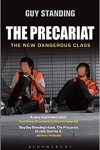
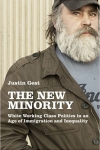
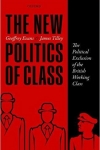
UK politics, not so long ago, was dominated by class: all else, we were told, was ‘embellishment and detail’. This seemed less the case by the last decades of the twentieth century, and now many in the psephological establishment have more or less abandoned any linkage between either the British party structure or patterns of voting at elections and class.
The reasons for that apparent shift are not difficult to discern. From the 1960s onwards, and especially after Thatcherism came to power, the working class on which the Labour party had depended for most of its electoral support and towards which most of its policies were aimed was in decline, both absolutely and relatively. Major industries were destroyed and the trade unions, which mobilised both support and money for Labour, went into decline. There were several decades of substantial social mobility as generations of young people from working-class backgrounds obtained educational qualifications formerly denied to them and filled many of the – often relatively lowly in pay and status – new types of job in the burgeoning middle class.
With the decline in its support base, Labour eventually realised that power could only be won with the votes of a substantial segment of the middle class – hence its rebranding as ‘New Labour’ and a changed focus in policy direction. Its rhetoric and support for the (albeit restructured) welfare state should have sustained its popularity with the diminishing working class, but victory – as 1997 and 2001 proved – was only achievable by winning more votes in the Conservative party’s ‘natural territory’ – the middle class – where the competition was intense: not only with the Tories but also with the Liberal Democrats and the Greens, who were establishing support niches there too.
But the working class, although smaller, hadn’t gone away – and its members remain as disadvantaged as before, as Geoffrey Evans and James Tilley’s excellent new book clearly establishes. Whether class membership is defined in the traditional way – by occupation – or the new – educational qualifications that now provide the tickets to (relatively well-paid and secure) jobs – there is still a substantial working class that differs significantly in policy preferences and values from its larger contemporary. And, as they firmly demonstrate in The New Politics of Class: The Political Exclusion of the British Working Class, those differences are reflected in its members’ political/electoral behaviour.
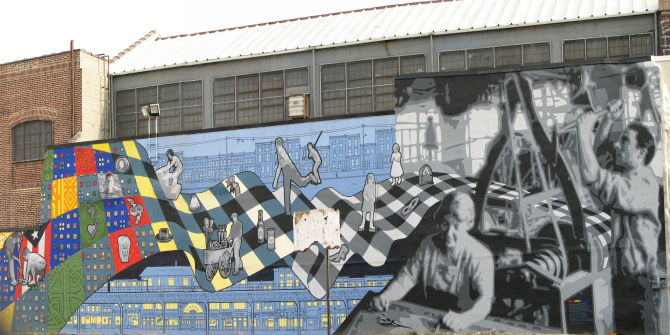 Image Credit: Kensington Mural (chrisinphilly5448 CCO)
Image Credit: Kensington Mural (chrisinphilly5448 CCO)
The nature of that behaviour has changed, however. Whereas the middle class is largely divided between those who support the Conservatives, Labour, the Liberal Democrats and the Greens, the main cleavage in the working class in the first decade of the twenty-first century was between those who continued to vote Labour (delivering it a slew of safe seats in (ex-) industrial Great Britain) and those who no longer voted at all. Evans and Tilley show an ever-widening gap in turnout between the proletariat and the intelligentsia from 1985 on, with a chasm opening up after 2001. Then, UKIP and the SNP came along and offered the working class further options – devastating Labour support in Scotland in 2015 and (as yet only) threatening some of its strongholds in much of northern England and south Wales.
Class and its accoutrements have not disappeared from the British electoral scene, therefore. Details of that landscape have been altered – mainly by the parties and their accomplices in the media – with focus increasingly on the hopes and fears of the middle class to which most parties direct their attention. This is reflected in much recent political science scholarship that dismisses class as irrelevant and instead attends to the issues that divide the majority middle class. Evans and Tilley show the failings of that position. Their book is based on much careful data analysis, but the text is entirely accessible and the arguments are presented through a large number of clear graphs and tables whose appreciation needs no technical skill.
The New Minority: White Working Class Politics in an Age of Immigration and Inequality is a further contribution to a rapidly growing literature on the consequences of globalisation – particularly de-industrialisation, inequality and immigration – for the remnants of the working class in advanced industrial nations: in author Justin Gest’s cases, the UK and the USA. His core argument is that the working classes there have become marginalised, especially those whose family livelihoods were sustained by large-scale industries. But, just as Evans and Tilley argue, they haven’t gone away. Most of Gest’s discussion is based on detailed ethnographic fieldwork in two locations: East London (essentially the Borough of Barking and Dagenham), where the Ford Motor Company used to be the dominant employer, and Youngstown, Ohio, a major centre of the US steel industry before it, too, fell on hard times. The book is rich in the appreciations that he provides of these two places, although there is more detail on Youngstown than East London in some parts (and there are some errors regarding the latter: according to Gest, UKIP did not contest the 2010 UK general election! (189)).
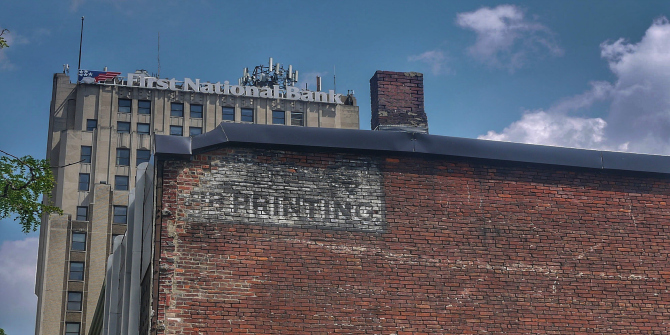 Image Credit: Youngstown, Ohio (5chw4r7z CC BY SA 2.0)
Image Credit: Youngstown, Ohio (5chw4r7z CC BY SA 2.0)
Gest’s interests are wider than political activity alone, and within that topic they are broader than Evans and Tilley’s. He divides working-class residents in the two places into those who are ‘pro’ and ‘anti’ the system, and those who are either active or passive politically. (The four cells are incorrectly categorised on page 34, but correctly on 117.) The first cell of this fourfold typology – active, pro-system individuals (‘democratic engagers’, in his terminology) – contains those who continue to operate within democratic institutions, including by voting; passive, pro-system individuals (those ‘sitting out’) currently feel no motivation to participate, but have not outright rejected it. (They might, for instance, vote on a particular issue, which some commentators – though not Evans and Tilley – suggest was the case with many working-class British people who voted almost certainly for Leave in the Brexit referendum but had no intention of participating in any future elections.) Among those against the system, those active (the ‘rebels’) seek to circumvent or overthrow it (through bodies such as the British National Party and the English Defence League), whereas the passive (the ‘withdrawn’) are politically inactive. The validity of this typology is tested using survey data, with stronger results for the USA than the UK (only the democratic engagers, those sitting out and the withdrawn appear in Evans and Tilley’s similar analyses, though they are unable to separate out the last two categories.)
There are variations between East London and Youngstown, reflecting differences between the long-established, relatively fixed British hierarchical class system and the much more fluid and flexible structure built around the ‘American dream’. Many in the British working class have created a new ‘other’ for themselves in the immigrant populations: the welfare state created, they believe, for the white working class after the Second World War now favours those populations, presenting a focus for feelings of relative deprivation. In the United States, on the other hand, many of the now-deprived working class or their parents are immigrants. But Trump, and the Tea Party before him, appealed to many of them, separating them not only from more recent immigrants (Hispanics and Muslims), but also from African Americans in their feelings of relative deprivation. And yet, Mahoning County, where Youngstown is located, gave majority support to Hillary Clinton in 2016 – by a smaller margin than it did for Barack Obama in 2012, but still sustaining the identity that many had developed over the decades with that party.
Gest argues that his case studies reveal what he terms a ‘near-constant internal dialogue’ in both East London and Youngstown for an industrial white working class who feel they have been displaced to their society’s periphery. They have been disempowered by that marginalisation, with those who have become either sitters-out or withdrawn seeing a wider gap between their expectations and what they receive than those who remain engaged: the rebels perceive the largest gaps.
But is it only the (ex-)industrial white working class who are becoming disengaged because of the growing inequalities that characterise the new global division of labour? Guy Standing’s book, The Precariat, paints a picture of societies in which many groups are being moved towards the edge through various forms of marginalisation and increased insecurities. Those changes stimulate anger, anomie, anxiety and alienation – the potential foundations for what his subtitle dubs ‘The New Dangerous Class’. The precariat is not yet a ‘class-for-itself’, collectively seeking freedom and basic security, but is instead a ‘class-in-the-making […] increasingly able to identify what it wishes and what it wants to construct […] an ethos of social solidarity and universalism, values rejected by the utilitarians’ (181) who have created the global liberal society. Too many people are denizens, not citizens, and in his chapter on ‘A Politics of Paradise’ Standing sets out what he considers is needed to change to make us all citizens.
 Image Credit: New Jobs, New Shops, New Homes (Alan Stanton CC BY SA 2.0)
Image Credit: New Jobs, New Shops, New Homes (Alan Stanton CC BY SA 2.0)
This 2016 reprint of the original 2011 edition of The Precariat contains no new material, but it remains a substantial contribution to our appreciation of continuing changes in labour markets and associated institutional structures as well as of who benefits and who loses from them. Societies, being built on ideologies of competitiveness, meritocracy and flexibility, have growing precariats: workers who lack the relative security of jobs in the elite, the salariat, the ‘proficians’ (professionals and technicians) and the traditional working class, comprising not only those whose secure futures disappeared as the working class contracted, but also increasing proportions of the young, many of whom, despite their education, have dismal prospects, as do many migrants. Standing’s book is full of examples of how more and more people are being tipped towards, if not outright into, the precariat, set within a firm theoretical structure. They are not only being marginalised, but also demonised and subject to increasing surveillance, setting the foundations for a ‘politics of inferno’ which seeks to make the majority happy while the minority are forced to conform (a theme also of Lynsey Hanley’s recent book Respectable: Crossing the Class Divide).
These three books provide a welcome change to the recent psephological literature that dismisses class as a vital component of contemporary social structures. They are full of compelling evidence that the working class has not gone away – but it has been changed, and is changing itself accordingly (not least by opting out in large numbers from electoral politics). As the story builds, so the authors provide fascinating evidence on a variety of topics related to that general trend, such as Evans and Tilley on how many people retain a working-class identity after they become middle class (and the implications that has for future generations) and Standing’s chapter on ‘Labour, Work and the Time Squeeze’. They differ very much in their foundations and methods, but all three are accessible presentations of their different type of scholarship and will repay careful reading by those interested in contemporary trends – including why the UK chose Brexit and the USA chose Trump.
Ron Johnston is a professor in the School of Geographical Sciences at the University of Bristol and co-author of, among other books, From Votes to Seats, Putting Voters in their Place and Money and Electoral Politics. Read more by Ron Johnston.
Note: This review gives the views of the author, and not the position of the LSE Review of Books blog, or of the London School of Economics.





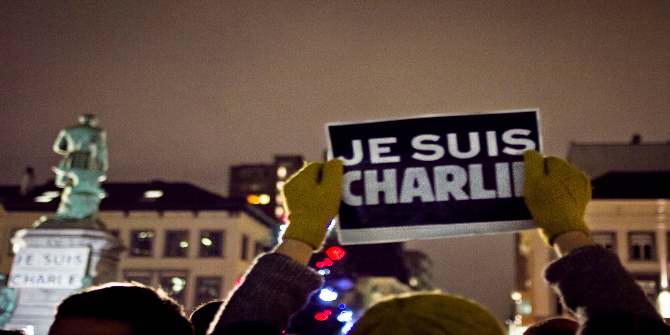

5 Comments